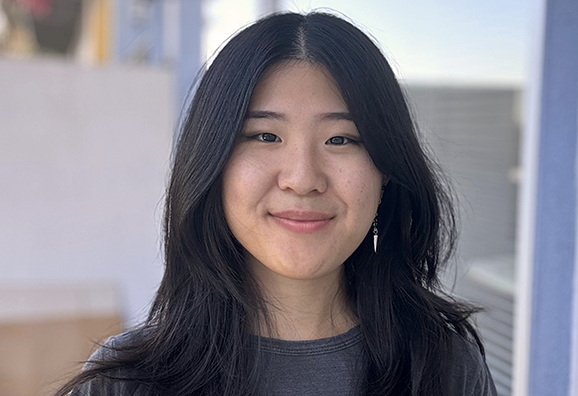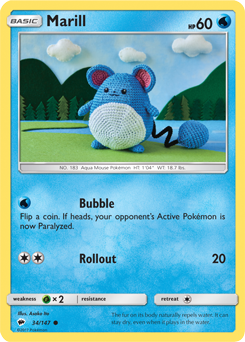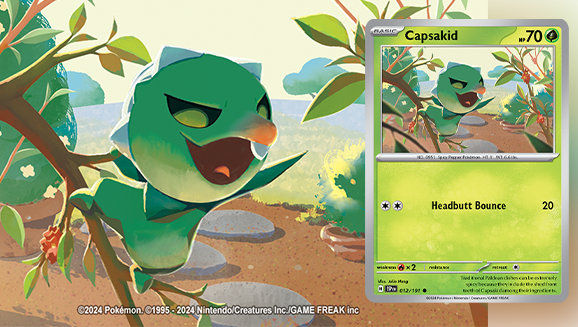The Pokémon Company has revealed a special feature highlighting the Pokémon Trading Card Game (TCG). Read on below to learn more:
Pokémon TCG illustrator Julie Hang shares her experiences drawing Pokémon TCG cards and dives into her latest work featuring Capsakid.
It was over a year ago that Pokémon Trading Card Game (TCG) illustrator Julie Hang finished as the United States first runner-up for the Pokémon TCG Illustration Contest 2022. Hang’s submission depicted the classic first partner Pokémon Bulbasaur joyfully gathering berries on a bright day, and the artwork was eventually enshrined in a trio of promo cards celebrating the contest. You can learn more about Hang’s Pokémon TCG Illustration Contest 2022 experience in her joint interview with fellow finalists REND and Taiga Kasai on the Pokémon TCG Illustration Contest website.

Since finishing as the United States first runner-up, Hang has become a full-fledged Pokémon TCG artist, illustrating Fletchinder for the Scarlet & Violet—Stellar Crown expansion and Capsakid for the newly released Scarlet & Violet—Surging Sparks expansion. We caught up with the talented “cardist” (card artist) to talk about her growth, inspirations, and how her latest Pokémon TCG illustrations came to be.
Why Pokémon? What was it about the world of Pokémon that inspired you to illustrate it?
Hang: I grew up with Pokémon. I have many fond memories of myself as a child eagerly waiting in front of the TV for Pokémon to air. Some nights, to my parents’ dismay, I’d stay up with my eyes glued to my Game Boy [Advance] SP playing Pokémon Sapphire. My cousins and I would even spend some afternoons role-playing, pretending we were Pokémon ourselves. These experiences are what inspired me to express my love for the franchise through drawing fan art. My favorite kind of fan art to draw were my teammates from whichever Pokémon video game I was playing at the time—it made me feel a closer bond with them!
Who are other Pokémon TCG artists (or other artists in general) who you’ve looked up to?

Hang: I love collecting Asako Ito’s cards. I’m constantly amazed by the adorable scenes she is able to create purely by hand. As a fellow crafter with a love for fiber arts, I recognize how much time and effort it takes to bring these artworks to life.

I collect HYOGONOSUKE’s cards as well. His charming depictions of Pokémon going about their daily lives is something I aspire to highlight in my own work. And his art style is just plain cute!

Tomokazu Komiya’s cards also have a special place in my card binder. His style is so cool and unique. You could easily pick his artworks out of a stack of cards—he’s like the Picasso of Pokémon cards.

Lastly, Whisker is a recent favorite of mine, ever since their contribution to the [Scarlet & Violet—]151 set with the Psyduck illustration rare. I absolutely love their use of color, with textured elements reminiscent of risograph and screen printing.
What is your preferred artistic medium?
Hang: With how often I’m drawing, this may come as a surprise to some: I actually prefer to express myself through crafts! I’m happiest when I pour my creativity into knitting, crocheting, and sewing. There’s nothing like completing a project that started in your head and is now in your hands.
How do you think your style complements Pokémon characters?
Hang: I have quite a few years of practice behind me drawing fan art of Pokémon, so I hope I’m doing them justice as an illustrator! When I’m working on a card, I aim to present a fresh take on the Pokémon that conveys their personality. I love using ultra-saturated colors and warm lighting in my personal work, so I like to think it adds to the playfulness that I’m going for when illustrating a card.
What are some of the most challenging aspects of drawing a small scene of a character to fit within a small card?
Hang: I work on a slightly larger size than needed, then scale the illustration down when it comes time to fit it to the card. That way, I get to draw at a size I’m most comfortable with without losing any of the image quality!

When you begin working on an illustration, how do you decide what you want the scene to portray?
Hang: If I were to take a snapshot of that Pokémon’s day, what would it look like? It would probably be having fun or relaxing in a variety of ways: playing, laughing, foraging, eating, climbing, running, sleeping, and the list goes on. I also think about how the Pokémon’s personality—whether it’s silly, calm, or serious—might influence the way it likes to carry out these activities. I start brainstorming ideas for the illustration from there.
Apart from Bulbasaur for the Pokémon TCG Illustration Contest, you also illustrated Fletchinder for the Scarlet & Violet—Stellar Crown expansion. What was that experience like, and how did it feel to see that card take flight earlier this month?

Hang: Fletchinder was my first card as an actual Pokémon TCG Illustrator, which was equal parts exciting and daunting. I wanted to make a strong impression with this card but was still finding my footing in terms of having confidence in myself as an artist. I decided it made the most sense to lean into the things I liked about illustrating, even if the style would be a slight departure from my Bulbasaur card. I had grown as an artist since Bulbasaur, and even now, I expect my art style to continue evolving in the future.
Once I let myself be OK with that, I found renewed confidence to make an illustration that I would personally like to see on a card. When I finally got to hold the Fletchinder card in my hands for the first time, I felt immense happiness. I’m so pumped that Stellar Crown has now been released in the US. Since it’s a common card, I’ll be more likely to come across it next time I go to the card store!
How does storytelling show up in your work? How do you use storytelling to compose an illustration?
Hang: After brainstorming ideas for the scene of the illustration, I start to dial in the specifics by asking myself some more questions: What’s going through this Pokémon’s mind right now? Does it have a goal, whether it’s something simple as taking a stroll through a forest, or something more serious like getting ready to evolve? I consider how the composition, camera angle, color, and lighting can be utilized to best answer these questions.
With my Fletchinder illustration, despite how its coloring starkly contrasts the blue background, the red leaves drifting in the wind alongside it help communicate that, just like them, Fletchinder belongs in the sky. This way, I was able to achieve my goal of maximizing Fletchinder’s vibrant coloring without making it seem out of place.
The Capsakid in my latest card is daring yet limber. With a personality not unlike that of a young, adventurous child, the Capsakid I portrayed climbs atop branches that may or may not hold its weight. It pays no mind to such precariousness, as long as it’s having fun. The morning lighting of the illustration tells us that Capsakid’s day is off to a great start.

What were your first impressions of Capsakid for this assignment? How do you feel about the Pokémon now?
Hang: My first thought was, “Where are its eyeballs?” Let’s just say that if I were to glance behind me and Capsakid was there staring at me, I’d be a bit frightened. At first, I found it to be a creepy-cute Pokémon. Now that I’ve gotten to know Capsakid a bit better, I’ve come to appreciate the happy-go-lucky, playful side of the Pokémon.
How did you research Capsakid before approaching this illustration?
Hang: Capsakid is a newer Pokémon, so I didn’t know as much about it when I was assigned to illustrate it. I researched about it online to gather more references regarding its design, and what Abilities and moves it has in the video games. I also looked at other Pokémon TCG cards featuring Capsakid to help me think about how I could portray this new Pokémon in a way that people haven’t seen yet.
What direction did you receive, if any, and how did you want to portray Capsakid in this illustration?
Hang: Like most of my illustration assignments, I was given license to draw Capsakid in any situation or scene that I liked. Capsakid is known as the Spicy Pepper Pokémon. When I was a child, my mom used to grow chili peppers in our backyard. When I think about Capsakid’s childlike appearance, I think it would have no problem hopping from backyard to backyard to fulfill its craving for adventure. As a result, it felt natural to me to depict Capsakid in a garden.
Were there any challenges specific to Capsakid?
Hang: Gardens are green, but Capsakid is also green. It was a challenge to light the scene in such a way that Capsakid wouldn’t get lost in the background. Additionally, I had to adjust Capsakid’s size a bit, walking the line between showing that it’s a small Pokémon while maintaining it as the focus of the illustration.
What Pokémon would you most like to illustrate?
Hang: It’s hard to choose just one! Let’s see… Seadra, Skitty, Latias, Roselia, Azumarill, Ditto, Corsola, Porygon2, Misdreavus, Oddish, Gengar… OK, I’m going to stop now before I get too carried away.
It would be amazing to see Julie illustrate any of these Pokémon, and it was a pleasure learning more about her journey! Look forward to future interviews at the Pokémon TCG “Cardist” Corner, where we learn more about the artists who bring Pokémon TCG cards to life.
Source: Pokemon.com
Source: Pokemon


